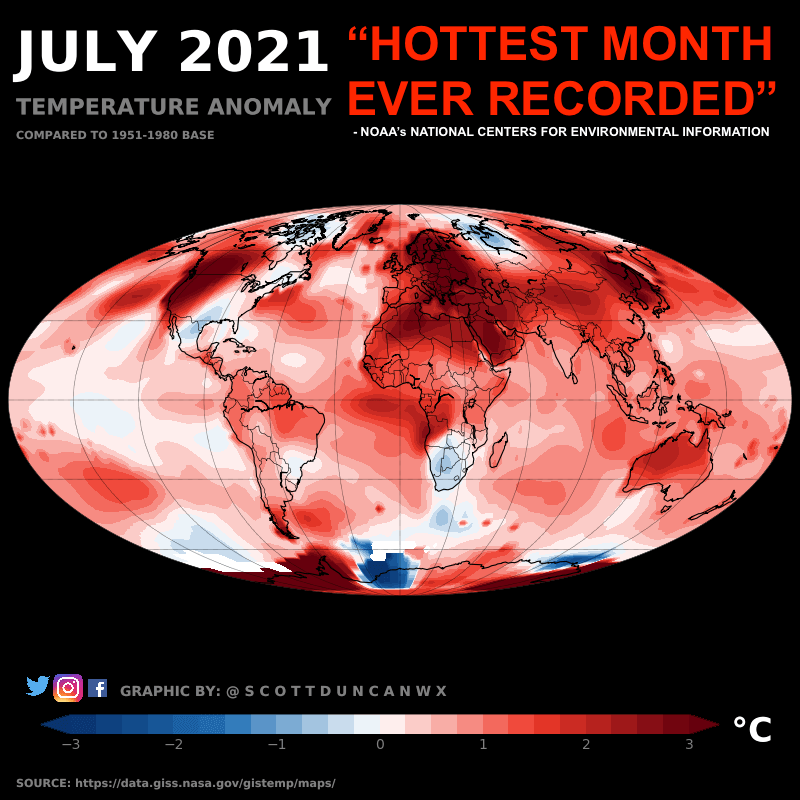“In this case, first place is the worst place to be,” NOAA Administrator Rick Spinrad said.
“This new record adds to the disturbing and disruptive path that climate change has set for the globe,” he added.
It was 0.02 of a degree Fahrenheit (0.01 of a degree Celsius) higher than the previous record set in July 2016, which was then tied in 2019 and 2020. The global surface temperature is calculated by averaging the temperature at the surface of the sea and air temperature over land: The ocean-surface water temperature is close to the ocean’s surface, measured using temperature sensors on satellites, buoys, ships, ocean reference stations, and throughmarine telemetry. The temperature of the air near the surface of the Earth is measured at meteorological observatories andweather stations.)
In the Northern hemisphere, which is experiencing summer during July, the land-surface onlytemperaturewas an unprecedented 2.77 degrees Fahrenheit (1.54 degrees Celsius) above average, surpassing the previous record set in 2012, per NOAA.

Asia had its hottest July on record, besting the previous record set in 2010; Europe had its second-hottest July on record-tying with July 2010 and trailing behind July 2018; and North America, South America, Africa and Oceania all had a top-10 warmest July.
Rising temperatures are a symptom of climate change: greenhouse gases in the atmosphere trap heat and cause average temperatures to increase.
These land-surface temperature measurements are alsouseful for farmers.Commercial farmers may also use land surface temperature maps like these to evaluate water requirements for their crops during the summer, when they are prone to heat stress. Conversely, in winter, these maps can help citrus farmers to determine where and when orange groves could have been exposed to damaging frost.
Climate change and warming are already affecting agricultural production around the world, albeit in many different ways. Changes in climate are not limited to increases in temperature and heat waves; large changes in precipitation patterns are also occurring, as discussed in previousWeather Corners. Some regions will suffer from droughts, while others will see the opposing issues of torrential rains and increased flooding.

Plus, coastal areas will experience rising sea levels which may result in complete loss of agricultural land. In addition, warmer climates may also lead to more pest and disease issues as insects that serve as a vector for disease transmission are likely to migrate further pole-ward in the future, where crops and livestock have not yet been exposed to these diseases.
Overall, future climate change will likely negatively affect crop production in low latitude countries, while effects in northern latitudes may be positive or negative.
The most direprojectionsare for tropical regions in Africa and South Asia, which are warming higher than the average global rate. In those regions, extreme heat and humidity are likely to putabout 1.5 billion people at riskby 2070.
Climate change will probably increase the risk of food insecurity for some vulnerable groups, such as the poor. For example, South America may lose 1–21% of its arable land area, Africa 1–18%, Europe 11–17%, and India 20–40%, according toa 2011 paper in Environmental Research Letters, although some researchers have different estimates.
Adapting to these rising temperatures will require new strategies.One 2021 paper in Oxford Open Climate Changeused data from 98 countries suggest to explore what nations are already doing to adapt to extreme heat: it found that decisions fundamentally differ by geographic region and national income. “In high-income, developed countries, heat is overwhelmingly treated as a health issue, particularly in urban areas,” the researchers wrote. “However, in low- and middle-income, developing countries, heat adaptations focus on agricultural and livelihood-based impacts, primarily considering heat as a compound hazard with drought and other hydrological hazards.”
In terms of agriculture, crop-level adaptation to climate change is expected to be key in minimizing future yield losses and may involve several tacks: changing crop cultivars, sowing time, growing techniques, and/or irrigation practices.
These adaptations are the subject of much agricultural and academic research. These include: restoring farm type or crop-scale diversity into food systems, to improve their resilience and making crop improvements that enhance stress tolerance. Other global-health strategies include developing pre-defined, international responses to food shortages in order to prevent food price shocks that might reduce people’s access to food.
